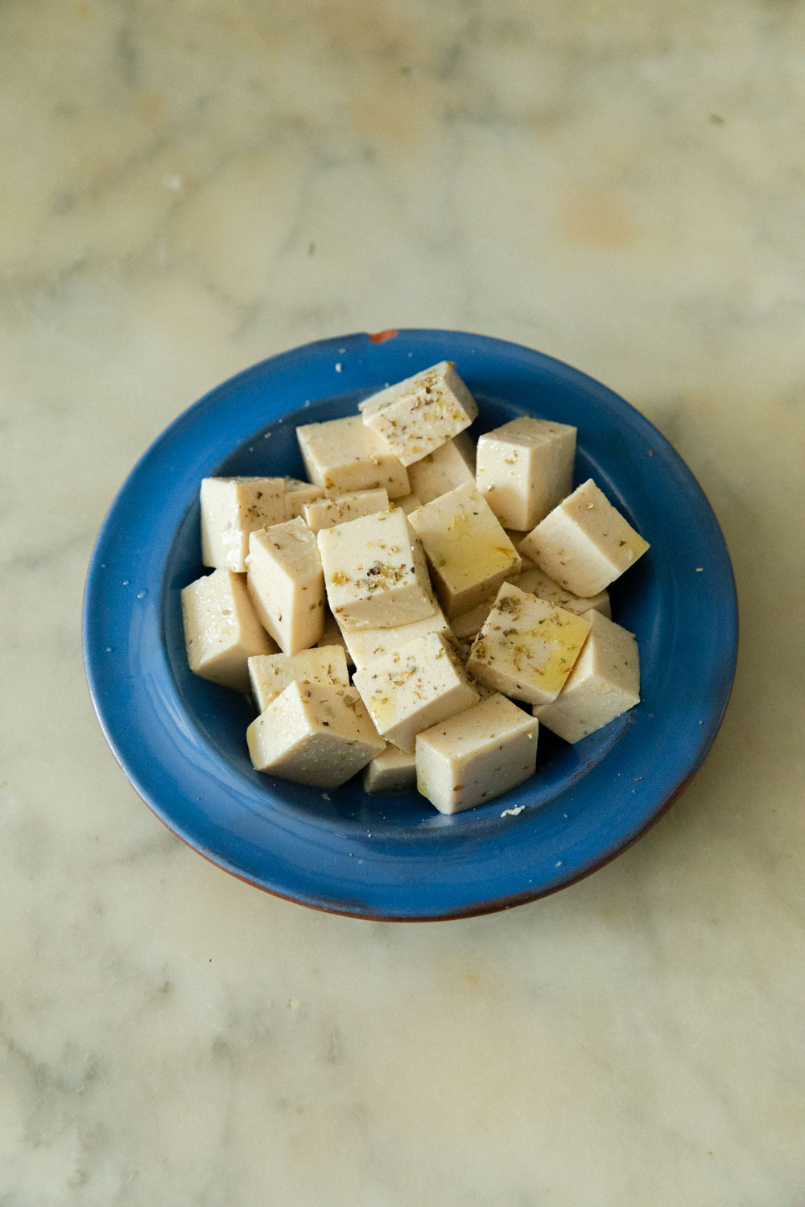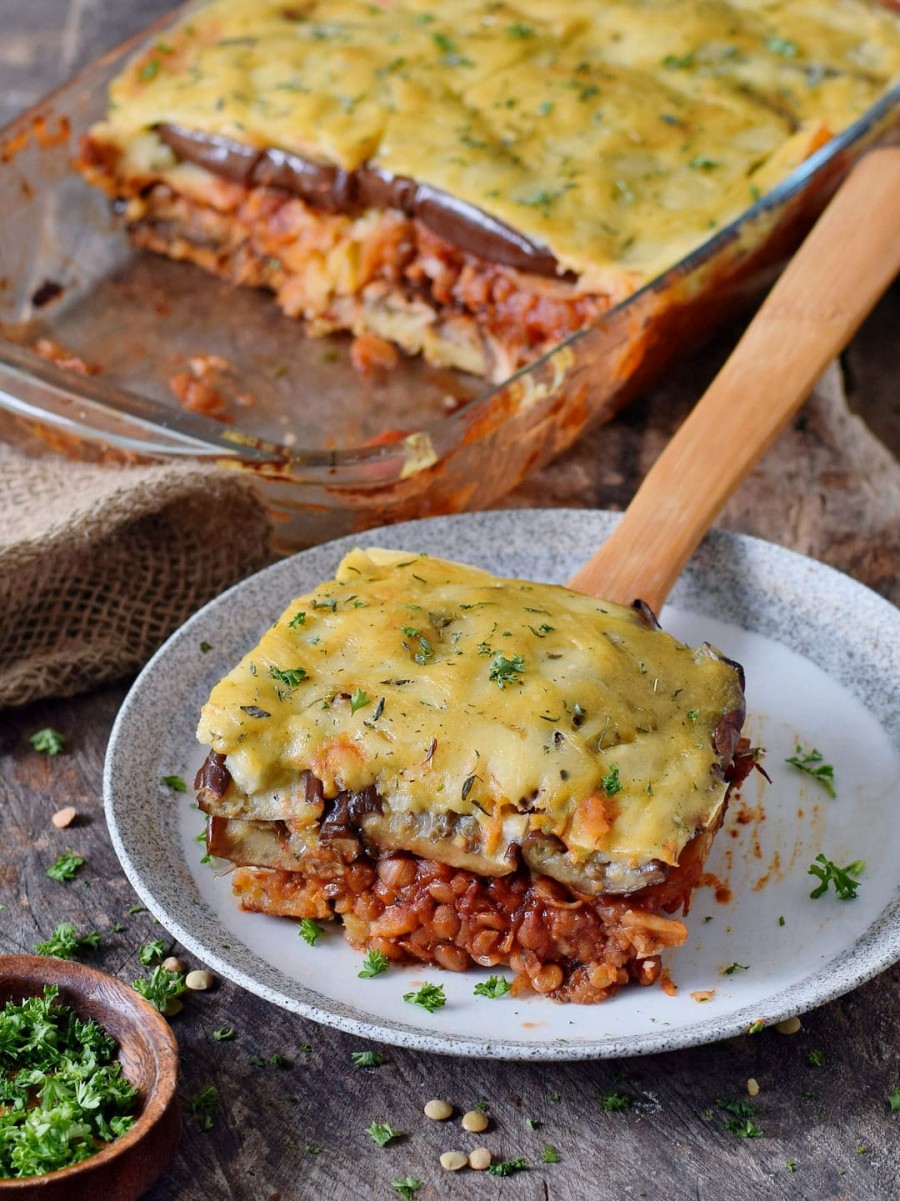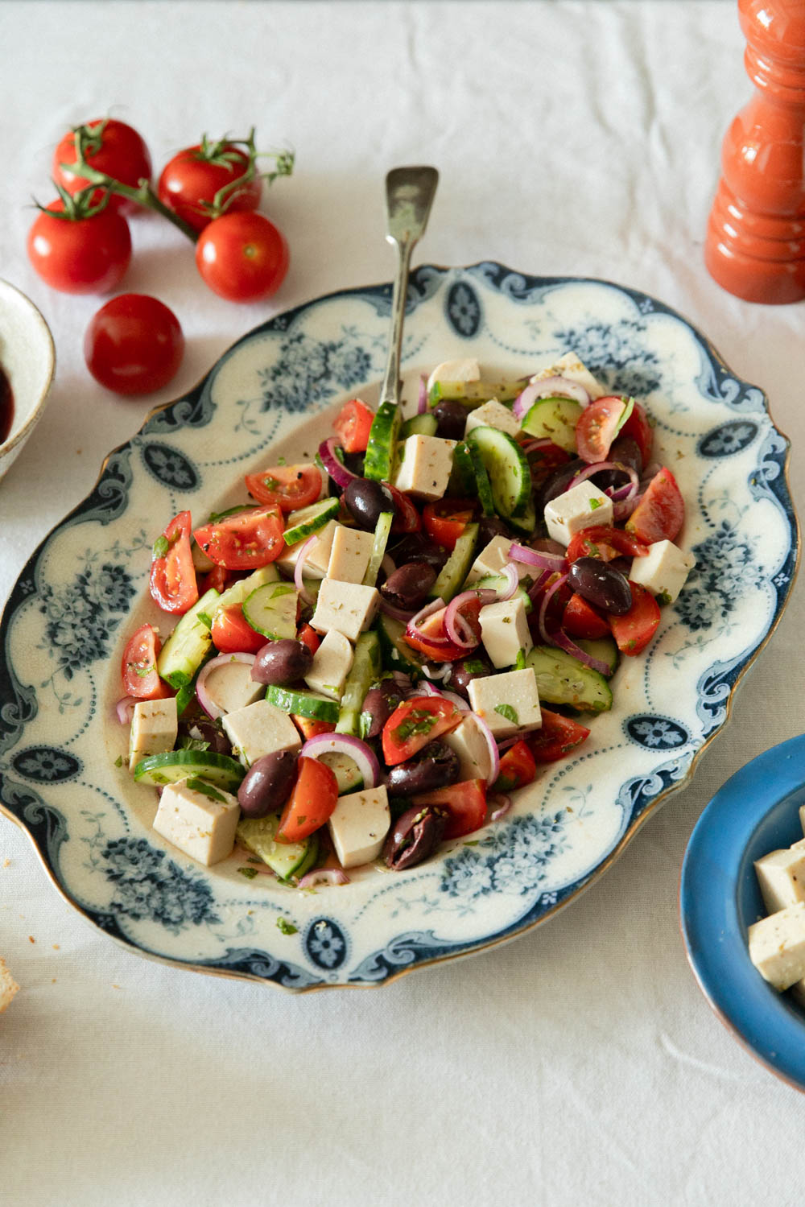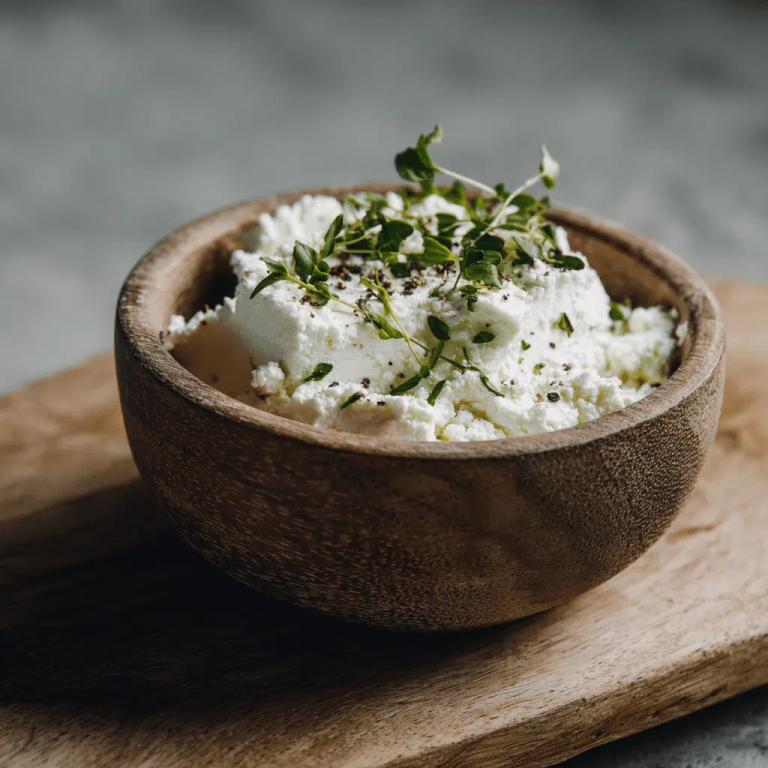
Greek food sings with bright herbs, ripe tomatoes, and good olive oil. It feels sunny, generous, and full of life. Going plant-based keeps that spirit, only lighter on the body and kinder to the planet.
This kitchen style suits vegans without fuss. Olives, beans, aubergines, courgettes, tomatoes, and herbs already sit at its heart. Keep the flavour, but swap the expensive plastic-wrapped ready meals!
This recipe for vegan moussaka (Jessica in the Kitchen) has quite a lot of ingredients, but they are all easy to find. The cheesy bechamel sauce tops roasted aubergine, potatoes and lentils, and the moussaka sauce itself is flavoured with yellow onions, tomato pasta, mushrooms, fresh parsley, herbs and dry red wine.
Avoid aubergine for nightshade allergies and inflammatory conditions. Before cooking, read up on food safety for people and pets (many ingredients like onion, garlic, mushrooms and fresh dough are unsafe near animal friends).
Greek cooking uses a lot of garlic and onions. Like citrus fruits and rhubarbs, just bin allium scraps (garlic, onion, shallots, chives, leeks), as acids could harm compost creatures.
Ingredients for Plant-Based Greek Recipes
Plant-based Greek cooking leans on simple, bold flavours. You will use fresh herbs, ripe vegetables, protein-rich legumes, crisp nuts, and golden olive oil. Each brings depth, texture, and nutrition without extra fuss.
Shop at local greengrocers, markets, and supermarkets for good value herbs and veg. Asian and Middle Eastern stores can be great for bulk chickpeas, lentils, and spices. Choose seasonal produce for better taste and a smaller footprint.

For dairy swaps, keep plant-based Greek yoghurt on hand. Coconut yoghurt gives body and tang in dips. Almond or soy yoghurt works well in dressings. Make your own vegan feta cheese or buy ready-made.
Choose extra-virgin olive oil for dressings and drizzles, and a lighter olive oil for cooking. It lifts every plate, so quality matters. Or sub with rapeseed oil, to support local farmers.
Whole foods power the nutrition. Chickpeas and lentils offer protein and fibre. Nuts bring healthy fats and crunch. Tomatoes, peppers, and greens give vitamins and colour. These basics reduce waste, cook fast, and fit into weekly meals with ease.
Herbs and Spices for Greek Vibes
- Oregano: Earthy and bold, perfect for roasted veg, salads, and marinades.
- Dill: Fresh and grassy, ideal in tzatziki, potato salads, and rice.
- Mint: Cooling and clean, great in dips, salads, and grain bowls.
- Bay leaves: Add depth to soups, stews, and beans.
- Cinnamon and allspice: A small pinch in tomato sauces adds warmth.
Grow a pot of oregano, dill, or mint on a windowsill for steady supply and low cost. Tear herbs by hand, add at the end, and let the heat wake the oils. A sprinkle of dried oregano on sliced tomatoes and olives gives instant taverna energy.
Read our post on indoor plants, to know toxic plants to avoid near pets. Never face foliage to gardens, to help stop birds flying into windows.
Veggies and Legumes: The Heart of Greek Dishes

Lentil Moussaka (Ela Vegan) is a lovely Greek dish, which replaces the lamb with lentils, tomatoes, potatoes and aubergine in a thick vegan bechamel sauce.
Choose seasonal UK produce. Tomatoes and cucumbers shine in salads. Aubergines roast and char well, ready for spreads and trays. Courgettes sauté fast and soak up olive oil and garlic. Peppers stuff well and bring sweetness.
Lean on chickpeas for hummus, stews, and crispy oven bakes. Use brown or green lentils in soups and tomato-based sauces. These foods add protein, fibre, and steady energy. They also store well, cook clean, and cost less than meat or cheese.
Simple Plant-Based Greek Recipes
These three recipes are quick, fresh, and true to Greek flavours. Each uses easy plant-based swaps without losing the spirit of the dish.
Creamy Vegan Tzatziki: A Cool Dip Alternative
Prep time: 15 minutes, plus chilling
Serves: 4 as a dip
Ingredients:
- 1 medium cucumber, grated
- 250 g unsweetened coconut yoghurt, or thick soy yoghurt
- 1 large garlic clove, crushed
- 1 tbsp fresh dill, finely chopped
- 1 tbsp lemon juice
- 1 tbsp extra-virgin olive oil
- Sea salt and black pepper, to taste
Steps:
- Grate the cucumber, sprinkle with a pinch of salt, and set aside for 5 minutes.
- Squeeze out excess liquid with your hands or a clean tea towel.
- In a bowl, mix yoghurt, garlic, dill, lemon juice, and olive oil.
- Fold in the cucumber, season to taste, and chill for 20 minutes.
Serving tips:
- Serve with warm pitta, crudités, or grilled courgettes.
- Add mint for extra lift, or a pinch of dried oregano on top.
- Use in wraps with roasted veg for a fast lunch.
Vegan Gemista: Stuffed Peppers
Prep time: 20 minutes
Cook time: 35 to 40 minutes
Serves: 4
Ingredients:
- 6 bell peppers, tops sliced off, cores removed
- 200 g rice, rinsed
- 1 onion, finely chopped
- 2 cloves garlic, finely chopped
- 400 g chopped tomatoes, tinned or fresh
- 2 tbsp tomato purée
- 2 tbsp fresh parsley, chopped
- 1 tbsp fresh dill or mint, chopped
- 3 tbsp olive oil, plus extra for drizzling
- 1 tsp dried oregano
- 250 ml hot vegetable stock
- Sea salt and black pepper, to taste
Steps:
- Heat 2 tbsp olive oil in a pan, cook onion with a pinch of salt for 5 minutes.
- Add garlic, rice, oregano, and tomato purée, stir for 1 minute.
- Pour in chopped tomatoes and half the stock, simmer for 5 minutes.
- Stir in herbs, season well. The rice should be partly cooked and saucy.
- Pack the peppers with the rice mix, leaving a little space at the top.
- Place in a snug baking dish, drizzle with olive oil, pour remaining stock around.
- Cover with foil, bake at 200°C for 30 minutes. Uncover and bake 10 minutes more until peppers are soft and lightly browned.
How to Make a Vegan Greek Salad

Most people that don’t care for salad, still like Greek salad. It’s filling and tasty, with vegan feta cheese. And makes a lovely summer lunch.
For 4 servings:
- Tomatoes, 4 medium: Ripe and firm, for sweetness and juice that tie the salad together.
- Cucumber, 1 large: Hydrating crunch, keeps the salad fresh and light.
- Red onion, 1 small: Sharp bite and colour; soak to soften the flavour.
- Green pepper, 1 medium: Classic crispness and slight bitterness that balances the sweet tomatoes.
- Kalamata olives, 80 g, pitted: Briny depth, the savoury kick that makes it taste Greek.
- Vegan feta, 150 g: Make your own (above) or choose Kinda Greek-style cheese
Dressing:
- Olive oil, 4 tbsp: Rich body and shine.
- Red wine vinegar, 2 tbsp: Clean acidity that brightens the vegetables.
- Garlic, 1 clove, crushed: Subtle heat and aroma.
- Dried oregano, 1 tsp: The essential Mediterranean note.
- Sea salt, 1 tsp, plus more to taste
- Black pepper, ½ tsp, freshly ground
Optional extras:
- Fresh parsley or dill, a small handful: Herbal lift.
- Lemon juice, 1 tbsp: Extra tang if desired.
Substitutions:
- No green pepper? Use yellow or red for a sweeter profile. In a pinch, use thin slices of raw aubergine, salted and rinsed, for a firm bite, though pepper is traditional.
- No Kalamata olives? Use good quality pitted black or Greek-style olives.
- No red onion? Use white onion or spring onions for a milder taste.
- No feta? Just use cubed vegan cheddar from local stores.
Creating a Creamy Vegan Feta Substitute

Quick tofu feta, ready in 5 minutes:
- 200 g firm tofu, pressed for 5 minutes between kitchen towels
- 1 tbsp lemon juice
- 1 tbsp olive oil
- ½ tsp dried oregano
- ¼ tsp sea salt
- Black pepper, to taste
Method: Crumble or cube the pressed tofu. Toss with lemon juice, olive oil, oregano, salt, and pepper. Let it sit while you prep the vegetables. It will soften at the edges and take on a bright, tangy flavour, close to classic feta. For extra depth, marinate for 30 minutes.
Prefer shop-bought? Choose a Greek-style vegan block that crumbles. The goal is tangy, salty, and a little creamy. This adds protein and that familiar finish.
Assemble Your Vegan Greek Salad
Tools: sharp knife, chopping board, large mixing bowl, small bowl or jar for dressing, salad servers.
Time: under 20 minutes.
- Chop the vegetables. Quarter the tomatoes, slice the cucumber thinly, dice the red onion, and slice the green pepper into short strips. See notes below for even cuts.
- Make the dressing. Whisk olive oil, red wine vinegar, crushed garlic, oregano, salt, and pepper until glossy and slightly thick.
- Combine the base. Add tomatoes, cucumber, pepper, onion, and olives to a large bowl.
- Add vegan feta. Crumble or cube and scatter over the vegetables.
- Dress and toss. Pour on the dressing, then gently toss to coat. Taste and adjust seasoning.
- Rest for flavour. Let the salad sit for 5 to 10 minutes so the tomatoes release juices that blend with the dressing.
- Serve at once. Keep the texture crisp by dressing just before serving.
Chopping and Preparing the Vegetables
- Tomatoes: Cut into quarters or sixths, depending on size, so each piece holds shape.
- Cucumber: Slice thinly into half-moons. Peel if the skin is thick or bitter.
- Onion: Dice small for better distribution. Soak briefly if you prefer a mild taste.
- Pepper: Slice into short, thin strips for easy bites.
Uniform cuts help every forkful taste balanced and look bright.
Mixing the Tangy Greek Dressing
Combine in a small bowl:
- 4 tbsp olive oil
- 2 tbsp red wine vinegar
- 1 garlic clove, crushed
- 1 tsp dried oregano
- Pinch of sea salt
- Grind of black pepper
Whisk until the mixture looks slightly opaque and smooth. For more acidity, add a little vinegar or lemon juice. For a smoother finish, add a pinch of sugar or a drizzle of agave. Oregano gives the classic flavour, so do not skip it.
Eat Like the Greeks (fact or made-up media?)

England doesn’t have the best reputation for nutrition (with high levels of obesity, heart disease, type-2 diabetes, cancer etc). And we are often told that we should all ‘eat like the Greeks’, as they have the healthiest Mediterranean diet in Europe.
Is this true? Partly. But often there are vested interests and inaccurate reporting, which kind of makes the story not so straightforward. Let’s take a look at the good bits to take, and the bits you can ignore!
Eating Well says that it’s perfectly possible to follow such a diet with plants, you don’t have to eat fish if you don’t want to (for ethical, over-fishing reasons or if you’re pregnant or nursing). Their dietitian suggests:
- Whole grains (brown rice, rolled oats, wholegrain bread, barley)
- Plant-based proteins (beans, lentils, chickpeas, tofu
- Nuts and seeds (not for young children or allergies)
- Healthy fats (olive oil, use rapeseed oil for cooking)
- Fresh fruits (organic apples, pears, berries and dried apricots/figs)
- Fresh vegetables (leafy greens, salad vegetables, garlic, onion)
- Dairy alternatives (oat drink is good)
Viva! reports that a recent study found that a plant-based Mediterranean diet was better for weight loss and health than one with fish. You can easily get omega 3 fatty acids from oils and nuts/seeds, without over-fishing or mercury poisoning.
Plus most fish eaten in England is not from lone fishermen, but from huge ‘city-sized ships’ that often by-catch other creatures like dolphins, sea turtles and sharks.
The four-month study assigned 63 adults with weight issues to eat the standard ‘healthy Mediterranean diet’ for 16 weeks, and put the others on a low-fat vegan diet, which showed they had less acid overload, and dropped an average 1 stone (6 kilos) with no change on the ‘eat like the Greeks’ diet.
This may be due to animal products being higher in acid, so linked more to weight gain and chronic inflammation. Which of course means you are less likely to exercise, if you are not feeling good.
Why Are The Greeks So Healthy?

A Greek person would never eat a ready-made moussaka, it will always be homemade with fresh ingredients. Greece has a very strong family make-up. So older people are rarely lonely, and often go to live with relatives, rather than in care homes (loneliness is known to increase both dementia and mortality).
Greek cuisine often focuses on plant-based meals during periods of religious fasting. Fasolada (bean soup) and briam (roasted vegetables) draw on local produce. While Greeks do enjoy cheese and yoghurt, they don’t rely on meat every day. The idea that the Greek diet is all meat and feta isn’t true.
Fresh fruit and veg are daily staples at Greek tables. Markets sell local produce picked at the right time, which means fewer preservatives and better taste. Salads with tomatoes, cucumbers, onions, and olives appear with almost every meal. Watermelon, oranges, and figs are common desserts. Greeks have always known the power of fresh, local food, not big imports.
Social life in Greece matters. Meals are about community, not just food. Family and friends eat together, talk, and spend time outdoors. Many rural Greeks work outside in gardens or fields, helping them stay active. The traditional Greek diet supports this lifestyle, combining fresh air with fresh food, which is a big part of their well-being.
The Myth About Fish Oils
People often say Greeks eat loads of fish, so their health comes from omega-3 oil. But that’s not the whole story. In the past, inland regions ate more greens and beans than fish.
Fish was a treat for special occasions or for those living by the sea. The main fats in the Greek diet come from plant-based omega 3 fats, like olive oil, nuts, and seeds.
Sunshine helps crops grow and brings people outside. With over 250 sunny days a year, Greeks get lots of vitamin D and can eat more fruits and vegetables grown close to home.
Greeks Don’t Binge Drink
Although more Greeks smoke cigarettes, Greeks rarely binge drink. Like Italy, you’ll hardly ever see anyone flailing on the street, because they’ve downed 10 pints of lager or 2 bottles of wine!






